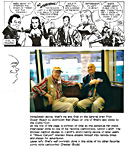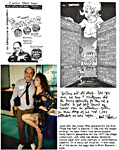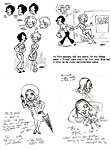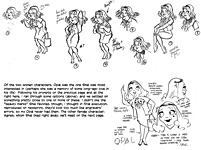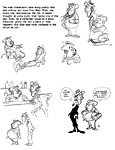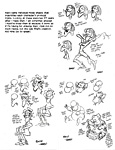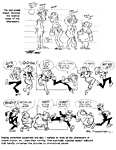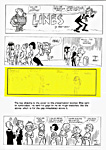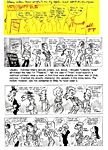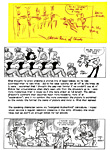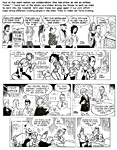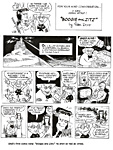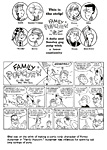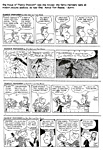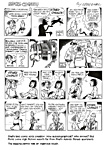 |
|||||||||||||||||
|
REMEMBERING SHEL: IRONY and THE FOUNDER OF THE COMIC-CON How He Lived and How He Died and Some of the Things We Did Together Friends of Shel Dorf knew for months that it was only a matter of time. Plagued by diabetes, he had been hospitalized for over a year, dialysis three times a week. Finally, at 1:15 p.m. on Tuesday, November 3, Shel died of kidney failure. He was 76. The love affair of his life began early and lasted long. Born July 5, 1933, Shel Dorf said he was “born again” when he saw his first comic strips at about the age of six—a book of Katzenjammer Kids reprints. When he was seven, he bought his first comic book—Sure Fire, No. 1, cover-dated June 1940. Hooked, he spent his 25-cent weekly allowance on the four-color pulps—Superman, Action, Blue Beetle, Super Comics, Disney titles, Captain Marvel, Bullet Man, Doll Man, Batman—or on movies. Of his two passions, comic books were favored because they were fungible: after reading and re-reading them, he traded them with friends for comics he hadn’t read yet. By the time he was ten, he was clipping comic strips out of the newspapers in his hometown, Detroit—which, at the time, supported three daily newspapers and, therefore, a fruitful plentitude of comic strips. The U.S. was then engaged in World War II on both sides of the planet, and newsprint was a vital ingredient in the manufacture of ammunition. All across the country, kids joined in the war effort by collecting newspapers, tying them in bundles and turning them in at schools and other neighborhood recycling points. Shel was a dedicated forager, taking his red wagon around the neighborhood every day after school to pick up discarded newspapers, house by house. And before bundling up his daily haul, he pulled out the comics pages, daily and Sunday, clipped the strips and pasted them in scrapbooks, six dailies on a single page, the facing page for the color Sunday. The pastime of the war became a life-long hobby, resulting in more than 500 scrapbooks, all of which Shel later deposited at the Cartoon Library and Museum at Ohio State University (except for a few he gave me). A particular favorite strip of Shel’s youth was Chester Gould’s Dick Tracy, and when Shel was fifteen, he went with his father on a business trip to Chicago and persuaded Dorf pere to take a 30-mile detour to Woodstock so Shel and his younger brother Michael could meet Gould at his studio. Shel had brought along a leather-bound book of Dick Tracy comic books that Gould signed, and Shel presented him with a watercolor painting he’d made. Writing in 1992 about the visit, Shel said: “I was so taken at meeting my hero that I was frozen stiff. Dad had to do most of the talking. Years later, Chet told me he thought my dad was one terrific father to drive his sons out to meet him. I was astounded that he remembered.” Through a lifetime of ardent devotion to the comics, Shel thawed out. No longer frozen stiff, he would come to know every major cartoonist in the country. Most of them on a first-name basis. Growing up, Shel worked in the family candy factory and, later, supplemented his weekly allowance by clerking in a drug store and working in a hubcap factory sweatshop. In grade school, he attended after-school classes in art; with his father as tutor, he took the famed Landon correspondence course in cartooning. He graduated from Cass Technical High School with a major in commercial art, and in Chicago, he took classes in design, fine arts, and the history of painting and architecture at the famed Art Institute. Back in Detroit, he joined the art staff of the Detroit Free Press, where he did photo retouching and some cartooning, and he also worked in a commercial art studio, doing layout and design. And then in April 1964, at the age of 30, Shel piled up all those of his comic books that he no longer wanted and took them to trade at the nation’s first comic-con, mounted at the Fuller Hotel in downtown Detroit by Robert Brosch. It was called a “swap meet”: the expression “comic-con” wasn’t in anyone’s vocabulary until that summer, when Bernie Bubnis coined the term in staging New York City’s first comics convention. Shel went to New York that summer, toured the New York World’s Fair and lived in the city for a short while and met Milton Caniff for the first time. Then he returned to Detroit and, with Brosch and Jerry Bails and Ed Aprill and a few others, mostly students like Carl Lundgren who was co-chair, began arranging for what Shel called the “Detroit Triple Fan Fair”—for “fantasy literature,” films, and comic art—held July 24-25, 1965, at the Embassy Hotel on Cadillac Square in downtown Detroit. In the program booklet, Shel appears as Chairman, saying, in a Statement of Principles, that “by establishing this convention, we hope to bring together people” with an interest in preserving rare material and to foster “the appreciation of Comic Strips, Films, and Fantasy Literature as genuine Art Forms.” Furthermore, “we hope to draw a close bond between the creative artist and his audience.” Shel went back to New York to live for a short time and renewed his acquaintance with Caniff, who Shel persuaded to appear at the New York Comic-Con. “I was told people came out of the woodwork to see him,” Shel said. In late 1967, Caniff put him in Steve Canyon as a football player named Thud Shelley—“Nothing has topped that,” Shel said. (Except maybe when Thud Shelley did an encore in 1973.) Returning to Detroit, Shel continued to “coordinate” the elements of the comic-con until the fall of 1969, when he moved to San Diego where his parents had retired. While settling into a one-room apartment at the back of a store in the hippie suburb of Ocean Beach, Shel encountered a circular with an ad about buying comics, and he sought out the advertiser, Barry Alfonso, who introduced him to Richard Alf, and the three started a club, the San Diego Society for Creative Fantasy. This bunch, all teenagers except Shel, through the agency of one of its members, Bob Sourke, soon amalgamated with another such group that had been meeting at what one of its number, Scott Shaw, called “a flyblown bookstore” at Ocean Beach (perhaps named, inexplicably, Andy’s News, or maybe Alert Books; sources differ) run by Ken Krueger, an adult, who had attended the “very first ‘scientifiction’ convention in 1939, officially making him a member of the elite-if-obscure group known as ‘First Fandom.’” Shaw and some of his sf fan friends had trekked north in 1968 to attend the World Science Fiction Convention held in Berkeley. Bitten by the con-bug, they soon “fell in” with Krueger, who harbored a flotilla of savvy “in fandom, conventions, publishing and retail sales.” “In 1969 [it was a Sunday, November 9], Shel arranged trips for many of us to visit Jack Kirby and his wife Roz at their home in Thousand Oaks, California,” Shaw wrote in 2005 in his Cartoonist-at-Large, and out of the Kirby-fan fellowship emerged the “social blob that was San Diego’s core of funnybook fandom,” which, by early winter, with Shel’s practical Detroit experience to guide them, was planning a one-day con for the following spring. The initial venture capital was supplied by Alf, who, though just a teenager, was one of the first mail-order back-issue dealers. Although the 2009 Comic-Con is billed as the 40th, it is actually the 41st. The first Comic-Con was that one-day affair held March 21, 1970 to test the waters and generate a little capital for the subsequent three-day affair, held that summer, August 1-3, and usually counted as the “first.” Officially dubbed the San Diego Golden State Comic-Con, it convened at the U.S. Grant Hotel, not “the snazziest of venues,” Shaw confessed, but the only hotel in town “willing to risk hosting an event that would garner such low bar-attendance” because the attendees were mostly teenagers. And most of them were male, Shaw says: “Other than young Jackie Estrada, now co-publisher [with her husband Batton Lash] of Exhibit A Press and administrator of the prestigious Eisner Awards [and, for many years, editor of the Con’s souvenir program], the only females at the 300-attendee event were fans’ mothers.” Krueger and Dorf signed the hotel contract—“the rest of [the sponsors] were under age,” Shaw explained. For the first Cons, Shel rounded up an impressive list of special guests—Jack Kirby, who attended every Con until he died in 1994, sf and monster maven Forrest J. Ackerman, Mike Royer, and sf authors Ray Bradbury and A.E. Van Vogt. In 1977—by way of demonstrating the growing appeal of the event—the guest list included Carl Barks, C.C. Beck, Robert A. Heinlein, Alex Nino, Stan Lynde, B. Kliban, Joe Shuster, Alfredo Alcala, Russ Manning, Harvey Kurtzman, Walter Gibson, Ralph Bakshi, Bob Kane, Jim Steranko, and Joe Kubert. Although Hollywood seems to have elbowed comics out of the room in recent years, movies were in the mix at the Con almost from the beginning: in 1976, attendees were shown slides from a movie called “Star Wars” a year before the film’s release. In 1971, the Comic-Con was already healthy enough to move to a more respectable locale, the San Diego campus of the University of California at La Jolla, August 6-8. The next year, August 18-20, another move—this time, to El Cortez Hotel, on a hilltop over looking downtown San Diego. In 1973, the Con added a day, meeting August 16-19 in the Sheraton Inn on Harbor Island, where attendance passed 1,000 for the first time. According to a post-con report, most of the attendees, 30%, came from San Diego with an additional 15% from the surrounding county, but almost 10% came from out-of-state. The Con generated a $200 profit, half of which was donated to the Academy of Comic Book Arts. Subsequent Cons returned to El Cortez (where, Shaw observed, “the swimming pool was clouded with fan-dispensed shark repellant”), branching out into the downtown Community Concourse for the exhibit. By the 1990s, the affair had grown to such an extent that only San Diego’s monster Convention Center could hold it. The 1973 Comic-Con program booklet reviews the Con’s history and names many of those responsible for the success of the previous events. Shel is listed as “founder and coordinator”; others whose names appear repeatedly are Krueger, Shaw, William Lund, Richard Butner, Bill Schanes, and Mike Towry. Tom French eventually joined the regulars to coordinate the “dealer’s room,” which, before too many years, had expanded into a full-blown “exhibition” that demanded floorplans and administration to keep track of space assigned and fees paid. The Con was run entirely by unpaid volunteers for years, but as it grew, the demand for a somewhat more committed staff grew, and by the late 1980s, Fae Desmond was employed full-time as the Con’s first salaried manager. Other paid staffers soon accumulated. Coordinating the efforts of the volunteer staff of the early years of the Con took hunks of Shel’s time, and he also devoted hours (and other resources) to promoting the event. Every year, he’d send copies of the souvenir program across the nation to cartoonists and writers and other potential guests, acquainting them with the opportunity the Con represented to publicize their work. To last year’s guests, he’d send photos of their appearances. He kept the U.S. Postal Service busy through rain, snow, sleet and hail. “The guy just lived and breathed comics his whole life,” said Mark Evanier, a comedy and comics writer who was involved in the Con variously from almost its beginning. “The Con was built on his passion and his cheerleading.” One of Shel’s earliest cohorts, Mike Towry, who was publicity chairman for the first Cons while 15 and 16 years old, said when he heard Shel had died: “He was a completely generous person who was wholly devoted to furthering the comic arts, bringing the fans and the professionals together. He never made a dime off Comic-Con.” Shel’s was always a non-paying role; to make a living, he freelanced commercial art. And in 1975, he landed his dream job, his only steady employment since the days at the Detroit Free Press. Shel had been a regular visitor at Milton Caniff’s studio in Palm Springs since Caniff moved there from New York in the summer of 1970. And when Frank Engli, Caniff’s letterer, died, Caniff (after an abortive hire of a religious fanatic who wouldn’t letter words he didn’t approve of) asked Shel if he’d like to try out for the job. Shel tried out and landed the assignment. It ushered in Shel’s happiest years. Caniff phoned Shel once a week to dictate dialogue for the next batch of strips, and Shel ruled panel borders and lettered speech balloons on blank artboard, then sent them on to Caniff for him to draw on. They’d spend hours on the phone, talking about the strip, movies, the latest tv shows, and events both current and historic. Shel loved those times. Shel resigned as “founder and president” of the San Diego Comic-Con in 1984. At the time, he explained to me that he felt it was “time to move on” or some such evasion. Later, after our friendship had matured somewhat, he said he’d quit because he couldn’t stand the political atmosphere in the committee meetings anymore: the emphasis was shifting to Hollywood and motion picture stars, and not many of the committee, he claimed, were any longer fans of comics and cartooning. The Con, he said, had become “this huge monster” that he no longer enjoyed. That was his side of the story; there’s another side that we’ll hear about anon. When Steve Schanes started Blackthorne Publishing in the mid-1980s, Shel joined the enterprise to produce a series of 72-page square-back booklets reprinting famous newspaper comic strips, supplying camera-ready pages of strips harvested from his scrapbook acreage. After a couple dozen volumes, the Dick Tracy series evolved into a 32-page monthly magazine, also edited by Shel, who delegated the paste-up chores to teenage would-be artists. The delegation relieved Shel of the most tedious part of the production process, but he had another motive for doing it: he knew the work would teach the young artist aspirants professional skills that would be valuable to them in commercial art, should they actually get into it. Shel had created the Comic-Con by delegating jobs, and he was adept at the practice. Once he subcontracted an art job to me—drawing cartoon figures for the box cover of some sort of board game. Some among Comic-Con officialdom maintained Shel’s penchant for delegating hands-on work disqualified him as the Con’s founder: the work, they said, was done by others. True, but the inspiration came from Shel, and most of the Con’s organizers recognized his role. After about 100 issues of Dick Tracy Monthly, Blackthorne collapsed in debt and allegations of malfeasance by its owners. And then Caniff died in 1988. Shel, shattered personally and unemployed professionally, tried to withdraw from comics fandom. He took up painting and focused on the history of the media he loved, comics and film. He attended Cinecon regularly and screened hours of old movies on DVDs at his Ocean Beach apartment. He did lettering and design jobs, but he was increasingly incapacitated by diabetes and wasn’t able to pound the pavement to find work as he had once done. To make ends meet until he started drawing Social Security, he sold original art from his collection. Sometimes, rarely, he evoked Porgy’s song from “Porgy and Bess”—“I got plenty of nothin’”—“but, like Popeye,” Shel was quick to add, “I yam what I yam and tha’s all I yam.” And he regarded the Comic-Con with affection and pride. “I have the feeling that I ‘done good’ by establishing the Comic-Con,” he wrote me. “It does help a lot of folks! For the most part, it’s a happy thing. I know I’d feel terrible if it ended.” Mike Towry wrote Shel in 2002: “It is impressive what the Con has evolved into, but it has only had the chance to do so because it was founded upon your true love of comics, their creators, and their fans, and because you generously shepherded it through its critical early years at material disadvantage to yourself.” Towry went on to report that his oldest son was a volunteer at the Con that year. By the time Shel officially “retired” from the Con in 1984, attendance had reached 4,000, and Hollywood, as I mentlioned, was becoming a big part of the mix. With the blockbuster success of movies featuring comic book superheroes in subsequent years, the invasion was complete. As Entertainment Weekly’s cryptic 2009 history of the event notes: “In the last decade, Comic-Con has exploded into the most important pop culture event on Hollywood’s calendar—a frenzied marketing free-for-all where, each July, major studios and networks flaunt their coolest new projects, trying to woo an audience of 125,000 sci-fi, fantasy, and horror fans.” Shel watched it and wasn’t entirely thrilled: “Hollywood has kind of hijacked the Con,” he said, his voice a gentle rumble, and in his eye, the glimmer of a twinkle. Comics fans are not what Hollywood is after. The number of comic book booths in the mammoth Convention Center’s exhibit halls is further testimony to the subversion of the Comic-Con to the power of celluloid and money in a capitalist society. Mostly, the booths display video games and motion picture tie-ins and toys derived from the lot. Comics are a small delegation; and old comics, the tattered and yellowed survivors of the Golden Age, are in even shorter supply. The guest list for the last dozen years or so included very few comic strip cartooners. In Shel’s regime, they were there in considerable numbers, their presence conjured by Shel’s insistent letters. For the last decade or so, comic book artists and tv and movie stars far outnumber the strippers. But a few years ago, the National Cartoonists Society began taking a display booth in the exhibit hall, and NCS members, predominantly comic strip ’tooners, appeared at a panel presentation together, discussing their craft. It was a feeble return, but it was a definite return. Shel took away with him many pleasant memories of his years with the Con and all that the association engendered. As Laura Embry wrote in a 2006 article in the San Diego Union-Tribune: “The convention helped him get more work as an artist and a writer and enhanced his reputation as a historian of comics. When Warren Beatty turned Dick Tracy into a movie in 1990, Dorf was a consultant.” And if there was a strip that captivated Shel more than Caniff’s Terry and Steve Canyon, it was Gould’s Dick Tracy. “Dorf can remember as a kid waiting on his front porch for the carrier to bring the day’s paper so he could learn what had happened to the square-jawed detective. He loved the stories, and he loved the artwork.” ***** I MET SHEL IN 1982. We were both attending Caniff’s 75th birthday party in Columbus, Ohio, at Ohio State University. A few months before, Caniff had asked me if I wanted to write his biography; momentarily floored, I accepted with alacrity and a transport or two of jubilation, exclaiming to my wife: “This is what everything I’ve done has been preparing me for!” Shel was responsible for my getting the assignment: he’d read something I’d written about Caniff and sent a copy to the cartoonist, who liked it well enough to offer me a job as his biographer. We’d exchanged a couple letters, but I didn’t meet him in the flesh until his birthday party at Ohio State. Shel dropped by my hotel room to pick me up and take me to meet Caniff. Shel was happy that I’d accepted the biographer role. By this time, he’d been lettering Steve Canyon for seven years, and he made frequent trips to Palm Springs where he spent hours, sometimes days, with Caniff and his wife, Bunny, and Willie Tuck, Caniff’s office manager and general all-around factotum. More friend and family retainer than employee, Willie had been with Caniff since the late 1930s. Shel loved them all, and he romanticized Caniff’s marriage. “There’s a love story there,” he told me, “—I hope you can get it into the biography.” I suspect the love story Shel was talking about was mostly in his mind: he wanted there to be a great love story. And there was, indeed, a love story, but by the time I knew Milton and Bunny, theirs wasn’t the towering romance that Shel imagined: it was the ordinary love between a man and wife who have invested a life of time in each other. It was full of mutual regard and tenderness, but it was no longer a heart-throbbing romance. Shel, who never married—never, as far as I know, even came close—wanted heart-throbs somewhere in his life, and Milton and Bunny were the most convenient candidates. During Caniff’s birthday weekend, Shel told me he had an idea for a comic strip and wondered if I’d be interested in working with him on it. Sure, I said. And a few weeks later, we began exchanging letters and sketches. He called his brain child Lines; he wrote it, and I drew it. The idea was to make jokes out of lines—lines of people, lines of test tubes in a laboratory, lines of parking meters, lines of cars parked at the curb. Anything that could be lined up in a line could be grist for Shel’s comedy mill. Some of the jokes were about movies, and the people making the joke were standing in line to get into a movie theater to see the movie they were joking about. I learned later that Shel had concocted Lines some years before, drawing as well as writing it. He’d showed samples to Charles Schulz, with whom he was in regular correspondence (as Shel was with dozens of well-known cartoonists); Sparky applauded the concept—“Showing people standing in a line with the various bits of dialog leading up to some kind of punch at the end is a perfect gimmick,” he wrote—but he told Shel his drawings were below par: “The only thing that is going to keep you from selling the strip is your poor drawing. I think you should practice developing the rough sketches that you have for they have a wonderful spontaneity that is totally lacking in your finished pen work. Your backgrounds are also extremely careless. You should practice drawing cartoon figures with one continuous line, and concentrate on making them more pleasant to look at.” (When Shel told me about this exchange, he said: “Sparky said my drawings were lousy.” You can judge for yourself: I’ve included samples in the Dorf Scrapbook at the end of this remembrance.) Before we got thoroughly launched on the enterprise, Shel thought we should discuss the terms of our partnership, and he wanted Caniff as referee, so he arranged a conference call for the three of us. One of Shel’s questions was about divvying up the plunder, if any. I said: “Fifty-fifty—that way we’ll both think we got the short end of the stick.” Caniff laughed his approval. The strip didn’t sell, so the question was moot. Like Wiley Miller’s Non Sequitur (which started February 16, 1992, long after Shel first concocted Lines), the concept didn’t need a recognizable cast, but Shel wanted to populate the strip with a line-up of regulars. He knew that the real money in comic strips lay in merchandising the characters once they became modestly popular, so in anticipation of that eventuality devoutly wished, we needed licensable personalities. He suggested four characters, two men and two women. One of the men would be tall and skinny; the other, squat and roly-poly. Ditto the women. For the distaff pair, I had at first suggested a woman of ordinary physique and a blonde pin-up pal, but Shel didn’t want glamor and rejected both of my inventions. Subsequently, he designed the pudgy cuddly Opal; I designed the rest—Opal’s girlfriend Agnes, and the two men, Roscoe and Rollo. (I’ve included in the Dorf Scrapbook the concept sketches and model sheets for the Lines quartet as well as samples of the strips.) Oddly enough, Shel didn’t letter the strip: for that, he subcontracted to Don Foster, who, Shel told me with delight, had some pen points of the exact brand used by Henry Shikuma. Shikuma had lettered Pogo for Walt Kelly, and when Shel asked me what kind of lettering I liked, I said I liked his lettering in Steve Canyon but my all-time favorite was the lettering in Pogo during the 1960s. Shikuma’s lettering. I thought Shel might imitate Shikuma, but I never imagined that he’d arrange for the same kind of pen point to be used. Foster’s nibs may even have been willed to him by Shikuma; I can’t remember, now, what Shel told me. Still, when he told me about Foster’s pen points, it was a serendipitous moment. But Lines didn’t sell no matter how well-lettered. Or by whom. Shel had devised another comic strip in 1978: it was called Boogie and Zitz, about a mad scientist, Zitz, who created his own girlfriend, Boogie. She looked, not surprisingly, much like Boris Karloff’s Frankenstein monster. Shel produced it solo; it didn’t sell. But Shel, nothing daunted, conjured up at least two more comic strips: Family Popcorn in 1996 with Tom Reese drawing, and Spare Change in 1999 with art by a Mexican editorial cartoonist pen-named “Curry.” Neither of these sold either. Family Popcorn featured an ordinary multi-generational family in the television age, but Spare Change deployed a perverse concept: its protagonist, Velma, was a little old lady who pretended to be homeless and unemployed, standing on street corners begging “spare change” from passersby. At the end of the day, she went home to a splendid mansion owned by her daughter, a tv star named Delores Del Mar. There, Velma shed her ragged working clothes and slipped into something more comfortably luxurious, befitting her millionaire status. Although it was a gag-a-day strip, its heroine’s career betrayed an underlying entrepreneurial cynicism that I thought undercut the comedy and made the concept unappealing. But Shel liked it—perhaps because in her poverty, the old crone’s impoverished alter ego embodied the financial dilemma Shel himself had endured for several years in the mid-1990s. Not to make a psychological profile of it, but the parallel to Superman, though far-fetched, is not improbable: just as Clark Kent had a secret identity as a superhero, so Velma was secretly wealthy, and, by the same token, so, we might imagine, did the impecunious Shel have a secret richer self. And of course, he did—a life rich in friends and fond memories about comics and their creators. (Samples of all of these strips appear in the Dorf Scrapbook.) I attended my first Comic-Con early in the 1990s. Inside, the apartment was the ideal cozy size for Shel and his enterprises. His drawing board was in the livingroom, next to the window that looked out onto the courtyard, but there was barely room for this equipage: the room was about 10x10-feet, and most of it was filled with shoulder-high stacks of cardboard boxes in which Shel’s vast collection of comic strips, comic books, and other cartooning flotsam and jetsam were packed. Under several piles of file folders, magazines, and a stray book or two was a daybed, intended, probably, for overnight guests, but, when I first saw it, unusable under heaps of comics materiel. The walls were festooned with framed and unframed photographs and original cartoon art, all inscribed to Shel by the creators, testimony to his wide acquaintance among the nation’s cartoonists. His bedroom was about the size of a bed. At the foot of the bed was a tv set, and the walls were a honeycomb of shelving for videotapes, mostly old movies that Shel dearly loved. The last years of his life, I think he spent many of his waking hours watching old movies from his bed. The apartment had two other so-called rooms, a bathroom with a shower and a kitchen alcove with sink and stove and fridge. Most of the times I was in the place, Shel sat in a chair at his drawing table, getting up occasionally to pull a piece of original art off the wall or to dig something out of a box to show me or whoever else might be in the room. Then we’d talk about it. Sometimes the object of his show and tell would be a recent letter from some cartooning celebrity or a magazine with an article in it about a cartoonist or a book he’d just bought or a sample of the work of some young cartoonist whose career Shel was trying to advance. We talked about movies as well as cartooning. The third or fourth time I went out to San Diego for the Comic-Con, I stayed in a somewhat scabby beachfront motel a couple blocks from Shel’s place. By then, Shel was no longer attending the Con: his estrangement from the organizing committee was nearly complete, but he always wanted to know what was going on downtown and happily listened to my daily reports. We’d meet every morning in a little bakery across the street from his apartment, and after a couple breakfast donuts, I’d take a bus down to the Con. We reconvened most evenings, too, sometimes for pizza, delivered to his place. A year or so into this routine, Shel’s car died; he couldn’t afford to have it fixed, so it sat in front of his place, a hulk at the curb. Shel then became an expert on San Diego’s public transportation, which, like everything else he was knowledgeable about, he passed on to those in need of it. In this case, me. Gradually, I realized his straitened financial condition. He never said much about it; a proud man, he wasn’t complaining. Once, however, he showed me a copy of the Con’s financial statement that someone had sent him: it showed a balance of over $1 million in the bank (or some such colossal figure). At the time, I learned he was unable to pay his rent, but his landlord carried him, probably because he’d lived there for so long—over twenty-five years by then, I’d guess. Trying to help out, I’d buy things from him, things he offered for sale—a scrapbook of Long Sam strips, for instance. A year or so later, he’d started collecting Social Security, and his precarious existence eased somewhat. But he had to give up one of his favorite pasttimes—phoning people around the country to exchange the latest comics gossip. It was cutting a life-line. It was about then—early in 1998—that he unburdened himself to me about his relationship with the Con’s management. In a letter that he began by expressing shock at the recent death of Roz Kirby, he suddenly changed subjects and talked about why he quit the Con—the politics he wanted to avoid and so on. And then he said (and this is the only time he ever spoke to me about this matter): “It would be nice to get some money for those early days when I worked my butt off to establish it, but it will never happen.” And it didn’t. The supreme irony of Shel’s last years is that what happened to him echoed the original sin in the comics industry. For virtually all of the nearly 70 years of comic book history, the industry’s continued prosperity has been built upon the four-color fantasies of longjohn legions—do-gooders in brightly colored costumes, all inspired, at first, by the startling newsstand success of Superman, a super-powered being invented by two Cleveland teenagers, who subsequently sold their rights to the character for a 1938 page rate, $130 total. The publisher of Superman’s exploits was no more grasping and venal than the publishers of other pulp periodicals at the time; publishers always took the rights to the material they published, and the creators were paid a fee or a salary, but they lost ownership. Jerry Siegel and Joe Shuster invented Superman, but, after accepting their check for his debut appearance in Action Comics No. 1 (dated June 1938), they no longer owned the character and weren’t, therefore, entitled to much of the revenue he brought in to the publisher. Syndicated comic strip cartoonists were in the same boat: their syndicates owned the cartoonists’ creations. As comics fans came to realize the confiscatory nature of the comics business, they voiced alarm, then anger. And when Warner started cranking up a multi-million-dollar Superman movie in 1975, sundry notables in the profession began agitating for something to be done for Siegel and Shuster, who were described at the time as impoverished and ill. A noisy campaign eventually shamed Warner/DC into paying Superman’s creators each an annual pension. But for the previous quarter of a century, Siegel and Shuster, who, with Superman, had virtually created the comic book industry, had enjoyed no financial reward from their creation. Like Siegel and Shuster and scores of syndicated comic strip cartoonists, Shel was not able to enjoy a reward commenserate with his creation. The Comic-Con provided employment at decent wages for certain of its operatives. And the Con had also fostered the careers of scores of cartoonists, writers, movie producers and actors. But not Shel. Like Siegel and Shuster in the years before Warner granted them pensions, Shel was virtually penniless. And ill, suffering from diabetes. You’d think (wouldn’t you?) that Comic-Con officials, fans enough of the medium to know the shameful treatment that Siegel and Shuster endured before the pensions—you’d think those Comic-Con officials wouldn’t want to be guilty of the same original sin. Moreover, you’d think (wouldn’t you?) these Comic-Con officials, aware of Shel’s predicament (although doubtless not the extremity of his penury), would have done something. And, indeed, they tried. Or they believe they tried, which is much the same thing from their perspective. I was not at all privy to anything that happened between Shel and the Con’s officialdom, and I was too close to him to have any way of grasping and understanding the nature of the trouble. But Mark Evanier, who is another of Shel’s friends and is knowledgeable about Shel’s relationship to Con personnel, wrote about the predicament in his obituary for Shel (at newsfromme.com, Tuesday, November 3): “There's a long, uncomfortable story of how he came to be estranged from the organization. Many of us witnessed it (and tried to help) but it was one of those problems that just could not be solved, at least to his satisfaction. This isn't the place for a detailed account so I'll just say the following. Shel's zeal built the con but at some point, those doing the actual hands-on work of running it began to have problems with him. Fights erupted. The convention became too big, in both a practical and legal sense, to be run the way he wanted to run it. He was offered roles and jobs but none he liked, and he chose instead to stop participating and attending. I thought it was a mistake on his part but it was also his choice to make.” Evanier’s testimony doesn’t reduce the grinding irony of Shel’s situation in those last years, but it mitigates it somewhat. I understand the problem the Con officers faced. Shel was stubborn and proud. And he could be difficult. A big man, over six feet tall, he was normally a placid genial giant, a big friendly bear. But in his last years, he could change in an instant: he could go from friendly to ferocious if provoked. The provocation might be a casual, innocent remark that Shel, and only Shel, perceived as a slight, an insult. One evening when two or three of us had convened for pizza at Shel’s Ocean Beach apartment after a day at the Con, the prevailing conviviality turned awkward and ugly when Shel suddenly took umbrage at some comment that was, to the rest of us, wholly inoffensive. Shel lost his temper, raised his voice, and told the offending party to get out of his apartment. Another time, he started in on me, but I wouldn’t let him. We’ve been friends a long time, I said, and we’re not going to have a fight now. He cooled off. Once Shel’s pride and obstinacy almost destroyed his son-father relationship with Caniff. Shel angrily threatened to quit over some minor matter, and Caniff, whose reputation for affability was legendary, also had a temper, and when he hung up the phone after talking to Shel, he lost it. Throwing pencils and erasers and other portable parts of the studio furnishings around the room, he exclaimed hotly: “Now I’ll have to letter the thing myself!” Willie told me the story. (Or maybe she told Shel, and Shel told me.) After a while, the anger subsided. Caniff soothed Shel’s wounds by giving him a raise, and they continued as before. Shel had been contracted by Denis Kitchen to edit the Steve Canyon Magazine in 1983 but became so possessive about the publication that Kitchen had to severe their relationship after just three issues. In hindsight, the incident probably belongs with other instances of Shel’s having obstinately behaved in ways that provoked an unhappy outcome. It could be that Shel’s diabetes was affecting his personality; diabetes can do that, and the ailment got worse as Shel grew older. And he was, as I said, “difficult,” increasingly so. There’s no question that after a dozen years, he had developed a proprietary interest in the Con. No doubt he disagreed more and more often with the emerging new leadership in the organizing committee. Evanier identified one bone of contention: “One of the lesser but constant areas of disagreement Shel had with the management of the Con was his feeling that more attention should be paid to newspaper strips.” In any case, I suspect by the time Shel’s financial situation had bottomed out, it was too late to help him. He was too proud to accept what he would regard as charity. He’d nurtured the Con out of love for the artform and those who made their careers of it. Money wasn’t what motivated him. Not in those early, formative years of the Con. And after he resigned, he pretended to have other, all-consuming interests. Probably it was too late to do anything about Shel’s predicament even before it surfaced as a predicament. By the late 1970s—fairly early on—it was probably too late. But I wish someone could have seen it coming and headed it off, somehow. That might have erased the irony. A few years ago, Evanier took me aside one evening at the Reubens Weekend of the National Cartoonists Society and said, simply, “What can we do about Shel?” Was there anything we could do to make it right with him? To help him, to reward him. Mark explored possibilities, but it came to nothing. Given Shel’s stubborn pride and the lingering animosity among some Con officials about his behavior during his last years of active involvement, Mark and I were doubtless expecting too much. Hoping too much. As Mark observed in the obit, when Shel withdrew from comics, “he severed all ties with the convention and he wound up selling off (or donating to universities) his wonderful, extensive collection of comic strips and memorabilia.” But Shel always insisted that “he was not unhappy. ... I couldn't tell if he really felt that way,” Evanier concluded, “or if he just wanted me to think he really felt that way—so I just decided it was better for both of us if I believed he really felt that way.” Better for us all, but not, probably, true.
***** SHEL WENT INTO SHARP MEMORIAL HOSPITAL in about April 2008. He never left. He had fallen, I was told, and when I phoned him, he said that nothing was broken. It was not the classic fall-and-break-your-hip event. But they were keeping him there for observation. He sounded as if his stay would be brief. It wasn’t. Shel had long been house-bound at his place on Abbott Street. Diabetes had affected his feet; he had difficulty walking. Soon, he never left his home. I don’t know the connection between diabetes and kidney failure, but about six or eight months ago, Shel’s brother Michael told me Shel was undergoing dialysis three times a week. His hearing had grown so bad that he couldn’t receive phone calls; I phoned Michael instead. Michael faxed Shel a few sentences every day. I sent printouts of Rants & Raves; Gasoline Alley’s Jim Scancarelli sent sheets of syndicate proofs of the strip as he had been doing for years. But Shel’s eyesight was rapidly failing. Probably he didn’t see much of what we sent. But he knew we were thinking of him, and he had to know he was loved. Charlie Roberts, a longtime friend of Shel’s and a fellow member of the Southern California Cartoonists Society, visited regularly. Last summer, on July 30, he reported on a visit he and cartoonist Jim Whiting made to Sharp Memorial. Matt Lorentz, another SCCS member, had designed a poster-sized get-well card that he took around the Comic-Con, asking people to draw or write on it something that might cheer up Shel. Whiting and Roberts took the poster to Shel in his room at the hospital. “As many of you know,” Roberts reported, “Shel is not in very good shape and can’t talk because of a tube in his throat. He sleeps a lot due to medication, but he came around after a few minutes. He has been bed-ridden for many months, and also suffered a mild heart attack on July 11. Jim and I held the poster so Shel could see it, and we pointed out various sketches and names. As Shel was looking at the poster, a tear rolled down his cheek, and then another. Quite an emotional visit. He managed a smile and a wave when we were leaving.” On October 17, reported Pete Rowe at the San Diego Union-Tribune, Mike Towry and five other members of the first Comic-Con committee visited Shel. Each of them wore a special homemade badge. Shel couldn’t speak and had trouble seeing. He grabbed one by the shirt. "He pulled the badge close so he could see it," Towry said. Shel knew he was loved. Rossi said that Shel had been taken off dialysis, then slipped into a coma and died a week later. ***** THE COMIC-CON IS HIS LEGACY, Mark Evanier wrote, but “it goes deeper than that. Shel was a big booster of new talent. He wanted very much to be in comics himself and it was almost like he said, ‘If I can't make it, I'll do everything I can to help everyone else.’ He encouraged and aided a number of young writers and artists who went on to become major talents, and of course the very existence of that convention has made hundreds, perhaps thousands of careers not only in comics but in allied fields, as well. Those of us who care about comics are forever in his debt.” Later, Mark added that the city of San Diego is also a beneficiary, and Pete Rowe confirmed: “Today Comic-Con is San Diego's largest convention, annually drawing 125,000 attendees.” Big crowds like that are good for a city’s business: money that convention-goers spend has a multiplier effect in economic impact. Hotels and restaurants are built to handle the influx of people, and these businesses are staffed by local residents. Shel would be the first to say that creating and nurturing the Con wasn’t a one-man enterprise: it took work by many people, of whom Shel was only one. But to best understand the role of the “founder,” we can ask if the San Diego Comic-Con would have come into being without Shel. The answer, I believe, is, No. He brought the idea of a comic convention with him from Detroit, where he’d played a key role in the earliest comic conventions. In San Diego, he found a cadre of interested youths who were willing to do the work, and Shel was happy to delegate and coordinate their efforts. And year after year, he was the sparkplug, stimulating interest in the Con among fans and professionals alike, keeping the flame alive, coaxing it into a healthy blaze, until today, when it has become a delirious annual conflagration at the water’s edge. Thousands now attend the “swap meet” he was most instrumental in starting. Over the years, Shel shared many of his memories with me. One of them was a copy of a 1975 letter from Superman’s co-creator, Joe Shuster, who wrote Shel from his home in Forest Hills, Long Island, to express his gratitude at receiving, the previous summer, the Inkpot Award, the Con’s distinguished achievement trophy. Wrote Shuster: “It is great to know that, after all these years, I am still remembered—and that the original Superman art, the drawings that I created, still hold fond memories for all the faithful fans. I know that Jerry Siegel [who also got an Inkpot that summer] feels the same. ... Shel, I believe you are doing a great service to all the comic book artists and writers by granting them full recognition for their labor, talent, and creative work. Due to your devotion and diligent efforts, I am certain that future generations will have a much greater appreciation of the work done by the pioneers of the comic book world—and that the artists and writers who have contributed so much to this field will now receive full credit for their accomplishments.” That year, 1975, was the year Shuster and Siegel started receiving their pensions from Warner/DC. I’m not sure that Shel has received full credit for his accomplishment as “founder and coordinator” of the nation’s largest comic convention. Entertainment Weekly doesn’t even know who Shel Dorf is. But we all do, and we’re grateful. As Milton would say, Big Thanks, Shel. ***** Mike Towry started a tribute to Shel website: sheldorftribute.com. And the Comic-Con has also recognized Shel’s contribution at its website, comic-con.org. Now, here’s that Dorf Scrapbook I promised—pictures and notes of a lifetime comics fan, and samples of the comic strips he created.
To find out about Harv's books, click here. |
|||||||||||||||||

send e-mail to R.C. Harvey Art of the Comic Book - Art of the Funnies - Accidental Ambassador Gordo - reviews - order form - Harv's Hindsights - main page |
